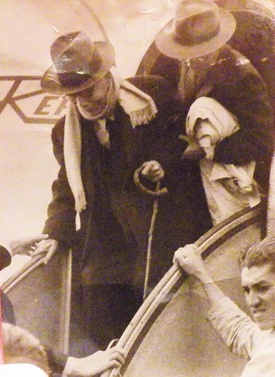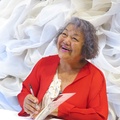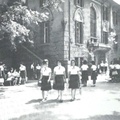Mizuno Ryu (1859-1951, Kochi Prefecture) was the man who launched the first immigrant ship, the Kasato Maru, in 1908 and started the Japanese immigration to Brazil. When I interviewed Ryuzaburo Mizuno (85, second generation), the son of this great contributor, I was truly surprised to hear him say with emotion, "My father died in despair, thinking that the immigration project was a failure... When the 100th anniversary of Japanese immigration (2008) was celebrated and such great praise was poured out on him by Brazilian society, the first thing I did was to tell my parents at their graves that after a century, their hard work had finally paid off."
There is the true image of the "father of immigrants" that only his family knew. In 1951, when Mizuno died, the aftereffects of the "win-lose struggle" that occurred just after the end of the war were still strong, and anti-Japanese sentiment in Brazilian society was quite strong. It is not surprising that Ryu Mizuno thought "it was a failure" on his deathbed.
However, the situation had changed dramatically by 2008, the 100th anniversary of immigration. In fact, it is still fresh in our memory that Japanese immigrants were even honored as an important factor in the founding of Brazil at the opening ceremony of the Rio Olympics in August 2016.
Ryu Mizuno was born as a samurai in the Tosa Domain during the turbulent Meiji Restoration, and became a radical activist in the Freedom and People's Rights Movement before becoming president of an immigration company. Without him, immigration to Brazil would not have begun. He even contributed to introducing Brazilian coffee to Japan, and eventually emigrated to Brazil himself with his family.
However, due to the lingering issue of the money entrusted to him by the Kasato Maru emigrants, he can be said to have been an unfortunate pioneer who has not been objectively evaluated.
Extremely Radical Civil Rights Movement Fighter
In 1878 (Meiji 11), when Ryu Mizuno was 19 years old, he gave a radical speech preaching the idea of freedom and civil rights in front of a crowd of residents at Jodaiji Temple, a famous temple in Sakawa Town, Kochi Prefecture, where he was arrested by the police and jailed for 40 days. This incident was the starting point that greatly changed the young Mizuno's life.
A speech by a 19-year-old youth was stopped by the police for being a disturbance of public order, and he was imprisoned for 40 days, leaving his name in the town's history. He must have been extremely radical.
The most astonishing anecdote in the "Ryuoden," compiled after his death, is undoubtedly the story of the attempted assassination of Okuma Shigenobu, leader of the Constitutional Reform Party.
"Together with his comrades, he built a bomb aimed at Okuma Shigenobu and tested it at the Aoyama Cemetery, but failed to achieve his goal" (page 7). Plotting a terrorist attack to assassinate Okuma Shigenobu, who would go on to become Minister of Foreign Affairs and Prime Minister, was too extreme, even if it was due to his youth.
It is not clear in what year this incident occurred, but since the Akita incident in 1881 (Meiji 14), radical anti-government terrorist incidents have occurred all over the country, and they are known as "intensified incidents," and it is possible that this incident was part of that trend.
If this terrorist attack had been successful, Mizuno's name would have been remembered as a dangerous man who changed the course of modern Japanese history. Mizuno would have been executed, and immigration to Brazil might never have begun.
"I thought my father was a bad person."
On the evening of July 13, 2011, when I visited Ryuzaburo at his home in Curitiba, Paraná state, he told me with a bitter feeling, "Because all the adults around me said bad things about Mizuno Ryu, I thought my father was a bad person until I became an adult."
"When I was old enough to understand, my father was in Japan. All the Japanese people around us would threateningly tell my mother, 'Mizuno tricked us and brought us to Brazil. It's only natural that you should take care of us,' and they would take food and money from us."
For a long time, even his son was unable to understand the existence of his father, who had achieved the unique feat of starting immigration to Brazil.
Ryuzaburo, born in February 1931, was born around the time the Pacific War began. In 1936, Ryu Mizuno began construction of the utopia of Tosamura (Akebono Colony, or Colonia Alvorada) in Ponta Grossa, Paraná, but ran out of funds midway and visited Japan in June 1941. Just as he had secured sufficient funds and was about to return, the attack on Pearl Harbor occurred, and he was stranded in his hometown of Kochi for 10 years during and after the war, leaving his wife and child behind in Brazil. This is what happened during that time.
"My mother never said a word in response to those Japanese people. She just kept repeating 'I'm sorry' and saying 'This is all I have for now' and gave them everything she had, be it money, things or food. My mother's hardships in those days were extraordinary. I grew up watching her like that," he recalls.
To his son, his father, who had left them behind, was not a great man. As he watched his mother's trembling, small back, he would often wonder with frustration, "Why didn't she say anything back?"

After the war, friends who looked up to Mizuno got together and formed the Ryuokai. They donated 50 contos for Mizuno's travel expenses back to Japan and sent him there. At 11:00 a.m. on May 19, 1950, Mizuno arrived by plane in his beloved city of São Paulo. He was already 91 years old at the time.
As his son Ryujiro worked for the Cotia Industrial Union, Mizuno Ryu lived with his sons in the union's staff housing in the Kasisigui district of the city of Sao Tome.
Ryuzaburo describes Mizuno's life there as follows: "Every morning, he would chant sutras starting at 7 o'clock, reading the names of hundreds of people from memory. He would give thanks to his benefactors involved in the Brazilian immigration project, the Kasato Maru emigrants, his relatives, and others, and would pray until around 9:30, rain or shine."
There must have been many people who were taken care of and indebted to him, and perhaps many who he was unfaithful to. It is reminiscent of the example of Akiyama Saneyuki, who served as staff officer in the operation that defeated the Baltic Fleet in the Battle of Tsushima during the Russo-Japanese War, and who, after retiring from the military, became a monk and devoutly recited sutras every morning, reading out the names of his fallen comrades.
Upon returning to Brazil, Mizuno begged his family repeatedly to take him to Alborada (the Akebono colony in Paraná state) as soon as possible. Maki had kept quiet about the fact that Alborada had been sold during the war, but finally, unable to do anything else, he told them the whole story.
When Mizuno heard this, he was stunned and passed away less than six months later.
He may have felt that all the hard work he had put in during his 10 years in Japan to raise funds to build Alborada had gone to waste.
On August 14, the founder of immigration to Brazil was buried in Terrno 121, quadra 36, Cemiterio Sao Paulo. The Ryuo Society built a magnificent grave for him and compiled and published the "Ryuo Biography."
© 2016 Masayuki Fukaawa






